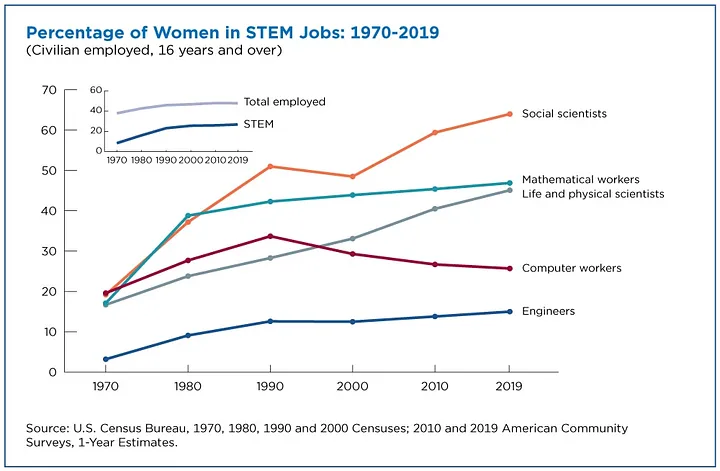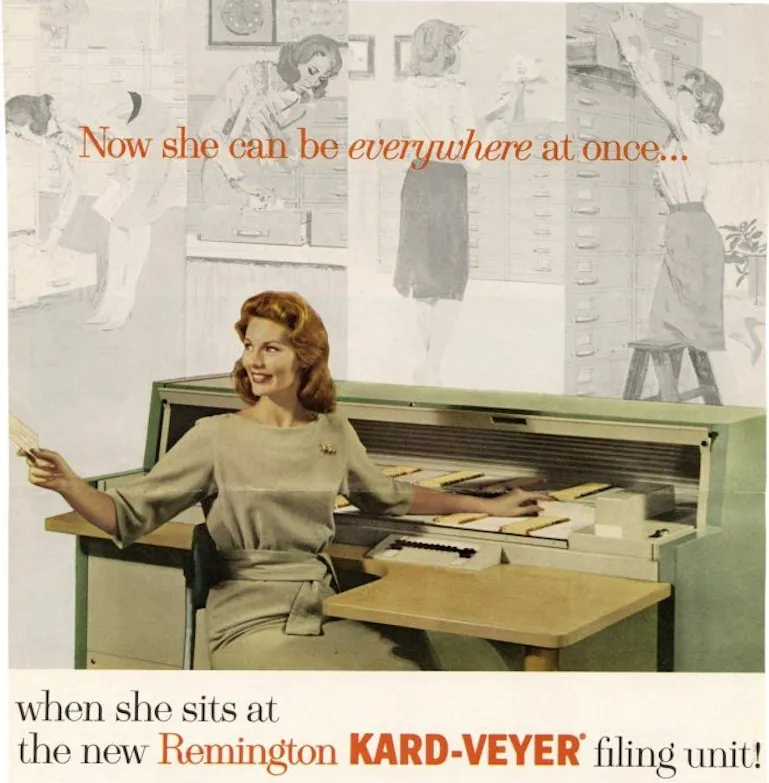The Lack of Women in Computer Science — A Hidden History and the Need for a Path to Inclusivity
Discover the hidden history of women in computing and their pioneering contributions that shaped the industry.
In recent history, computer science has been a male-dominated field. According to the National Center for Women & Information Technology, women made up a shockingly low 26% of the computer science workforce in the United States in 2019. Even worse, only 13% of US chief technology officer (CTO) positions were held by women in 2020. Thankfully, the proportion of women in computer science and related fields is increasing, but it’s still lower than in most other STEM fields. According to an article from the US Census Bureau, in 1970, women made up 38% of all US workers and only 8% of STEM workers. However, this representation has improved over the years, and in 2019, women made up 27% of STEM workers and 48% of all workers. In recent decades, women have made significant progress in STEM fields, particularly in the social sciences, where they now make up 64% of the workforce, up from just 19% in 1970. In addition, women were well represented in mathematics (47%) and life and physical sciences (45%) occupations in 2019, making up almost half of the workforce in these fields. *progress*

However, women have a long and significant history in computing that is often overlooked. The film and book “Hidden Figures” brought to light some of the incredible women who worked as engineers and early human computers (then a job description), also known as advanced mathematicians, at NASA. (If you haven’t heard of it, stop reading this blog post now and go watch the film). These women were not the only ones working in such positions, however, as women have played a significant role in computing for much of its history.
Today, women are underrepresented in computer science, but this was not always the case. Women have been an integral part of computing since its earliest days. For example, mathematician Ada Lovelace is considered the world’s first female computer programmer for her work with Charles Babbage on designs for a general-purpose, fully program-controlled, automatic mechanical digital computer called the Analytic Engine, in 1840. Throughout the 20th century, there were numerous notable women in computer science and programming, including Katherine Johnson, Dorothy Vaughan, and Mary Jackson, who were all featured in “Hidden Figures”. These women played a vital role in promoting US interest in the space race. Other notable figures in the field include computer scientist and Rear Admiral Dr. Grace Hopper, who was one of the first programmers on the Harvard Mark I computer in 1958, and Elsie Shutt, who started one of the first software companies in the world, staffed entirely by women, in 1946. (I mean, how cool are these women?!)
In 1945, John Mauchly, a physics professor, and J. Presper Eckert, an engineer, completed designs for a groundbreaking machine, the first electronic and programmable general-purpose computer, called the ENIAC computer. But, they weren’t alone in their pursuit of creating a computer that could solve complex calculations faster than any human could. The story of the ENIAC wouldn’t be complete without mentioning the women who were instrumental in its development. Jean Jennings, Marlyn Wescoff, Ruth Lichterman, Betty Snyder, Frances Bilas, and Kay McNulty were the female mathematicians who were responsible for programming ENIAC, handling the majority of the work that went into making it function. However, when the project was announced to the public in the same year, the names of the six women were omitted from the story. 🤯
So let’s take a moment to also celebrate the women and their achievements, acknowledging the impact their work had on the world of computing to this day. These men and women were pioneers who pushed the limits of technology and paved the way for the computers we use today. In the 1950s, it was widely accepted that programming was a suitable career choice for women, with the gender split in the field estimated to be between 30 and 50 percent. Women were well-represented in the industry and it was considered a normal and natural career choice for them. But there was a catch. Women were only considered for positions on the lower rungs of the industrial career ladder. A quick Google search for “sexist advertising campaigns in the 60s and 70s” will give you plenty of archival evidence of how women were perceived in the industry. (Exhibit A: this blog’s title picture, JWT Competitive Advertisements Collection, 1960, “Office Equipment”)
When we look at the industry now, it is important to remember the contributions of women in computing, as they have been an integral part of the field since its inception. From Ada Lovelace and Katherine Johnson, to Jean Jennings, Marlyn Wescoff, and Margaret Hamilton, these women broke barriers and paved the way for future generations. Despite this, women are still underrepresented in the industry today, with the gender split in computer science far from equal. But by acknowledging the contributions of these pioneering women, we can work towards a more inclusive and diverse future for the industry. By bringing attention to their stories, we can inspire a new generation of diverse young programmers, helping to create a fairer and more equal future for everyone in the field of computing. So let’s celebrate the achievements of these women, and work towards a brighter future for everyone in the industry.
Reference
Duke University, Story+ 2019, “Women in Tech Ads”.
Wikipedia, “Women in computing”.
The National Center for Women & Information Technology (NCWIT)”.
NASA, “NASA Engineers and Scientists-Transforming Dreams Into Reality”.
📰 Subscribe for more posts like this: Medium | Clemens Jarnach ⚡️
